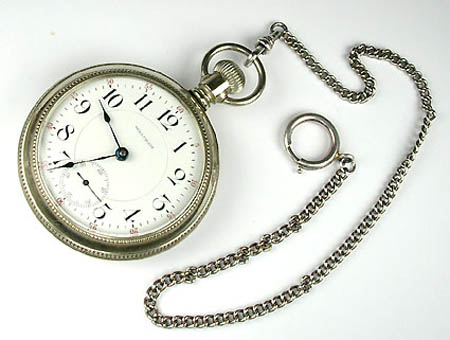
The Horological Steampunk – Episode I
Posted by on May 28th,2008So, you’ve decided that your Steampunk outfit won’t be complete without a pocket watch, and you’ve started to look around for a nice vintage one to use. What should you be looking for? What should you watch out for? What exactly is that watch you’ve found and is it a good one? Hopefully this first episode of ‘The Horlogical Steampunk” will start to answer those questions. In this episode, I’ll discuss the most visible component, the pocket watch case.
When you first look at a pocket watch, the most obvious component is the case. Generally speaking, the American pocket watch was sold in one of two types of cases: the open face case and the hunting case. The term open face is rather self explanatory in that it simply means that the face of the watch is open to viewing without opening a cover.
Lets look at a basic pocket watch, and get the terminology down.
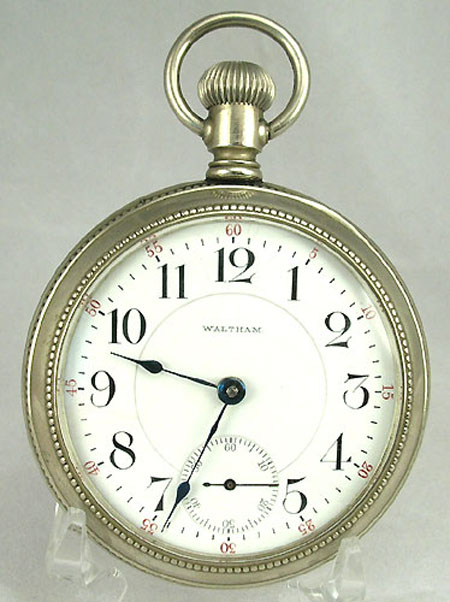
The ring at the top of the case is called the bow. This is where you would attach one end of a chain when wearing a pocket watch. Most bows are not fixed to the case and should pivot about the mounting points. Bows should not be overly loose or worn to the point that they could detach from the watch. The knurled knob inside the bow is the crown. The crown is used to wind the watch and set the time. The shaft that the crown sits on is called the pendant. The glass over the face of the watch is the crystal. The metal ring that holds the crystal is called the bezel.
A hunting case pocket watch has a protective metal cover over the face. Inside the case, the movement is oriented so that the crown is at the ‘3’ position. The front cover on the hunting case is opened by depressing the crown slightly. This will depress a latch to the point where the front cover can spring open. The front cover should open to approximately 90 degrees. If the lid opens farther than 90 degrees, a repair to the hinge may be necessary. If the lid does not spring open when the crown is pressed, a repair to the latch or the lift spring may be necessary. When you close a hunting case cover, do not simply snap it shut. Instead, depress the crown again to where the lid will clear the latch, then close the lid and release the crown. Simply snapping the lid closed will quickly wear the inside lip of the cover since the case metal is usually softer than the steel latch. Often the design on the front and back covers are the same with the only difference being the cartouche, which was left blank so that the owner’s initials could be engraved here. You may also see what is known as a demi-hunter, which is simply a hunter style case that has an opening cut into the face lid to allow viewing the hands without opening the case.
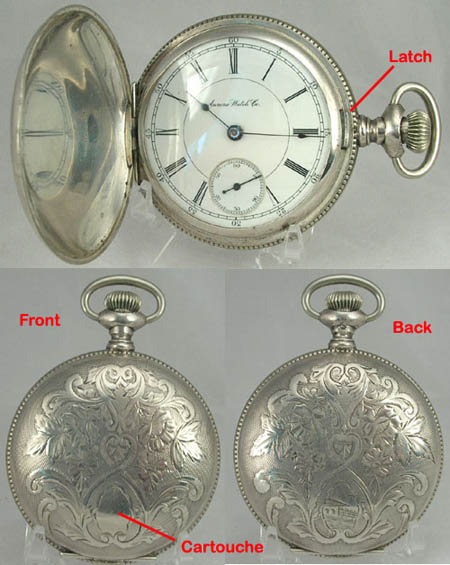
Sometimes you find a watch in an open faced case where the pendant is located at the ‘3’ position. This is sometimes called a sidewinder. In reality, it is simply a hunting case movement that has been recased in an open faced case. There is nothing rare or special about this configuration. There are sidewinders with “conversion dials” that put the seconds hand in the “3” position, thus allowing the crown to be in a normal position. Illinois made quite a few of these.
Another common thing with American pocket watches was that in the early days the company that made the watch did not usually make the case. Watch companies shipped completed movements to jewelers or distributors. Watch case manufacturers made a wide variety of cases available to jewelers. When someone bought a watch, they would first select the grade of watch movement they desired. Next, they would select a case and the jeweler would then case the watch for them. In later years, some watch companies made their own cases or bought cases directly from the case companies, and cased the watches themselves. It was still possible however, for a jeweler to recase a watch for the customer at the time of purchase.
Lets look at the non-hunter cases, and how to open them. Turn your watch so that you are looking at the side. In most watches, you will see two seams. These seams demark the 3 major components of the case. (If you do not see two seams, keep reading. There are exceptions and we will discuss them in a moment.) The middle part of the case, and the part that the pendant is attached to, is the body of the case. This is the part of the case that the watch movement is attached to. If you have an open faced watch, the front metal ring is the bezel. If you have a hunting case, the front part is the front cover or lid. The case back will be the part behind the watch body. Take a look at the seam between the body and the back, and look for a hinge somewhere on this seam? If there is one, then the back is hinged. Somewhere near the top, you will probably be a slight extended lip, as is shown in the photo at the right below. If the back is not too tight, you may be able to open it by pushing your fingernail in the seam between this lip and the case body. If you can not open the back cover with your fingernail, then you will need a case knife to open it. The blade on a case knife resembles that of a thin butter knife. The case knife is inserted into the seam between the lip and the case body and then given a slight twist. This should pop the cover open. Only do this if you are certain you can do it without damaging the case. If you are the least bit uncertain of this, please take your watch to a professional watch repairer, to find out how to open it without causing damage. It is also possible that, instead of a lip, you will see a slight separation in the seam somewhere opposite the hinge. As with the lip, this is where you would insert the case knife to open the cover.

If there is no hinge and no lip/separation visible, then the case back probably screws on and off. (See the photo at the left, above.) You should be able to screw the cover off by placing the watch face down in the palm of your left hand, placing the palm of your right hand over the back and then rotating your right hand counter-clockwise. The back may seem to be stuck, especially if the watch has been sitting for a long time in less than ideal conditions. Again, don’t proceed if you are unsure of how to proceed. (And, whatever you do, NEVER use WD-40 to ‘loosen things up’!) If the back does begin to unscrew, continue to unscrew it until you can lift it off. Another trick here is to use a pair of rubber gloves. Put on the gloves, and lay the watch face down in the palm of one hand, Place the other gloved palm over the watch, press down slightly and twist your top palm counter clockwise gently. This may give you enough grip on the case back to allow it to turn. Once you have the back cover off, you may be able to see the watch movement or you may find yourself looking at another hinged cover. This second cover, if present, is called the cuvette. The cuvette will almost certainly be hinged and will have a slight separation somewhere opposite the hinge where a case knife can be inserted to open it. When a watch was given as a gift and if the gift giver wanted to personalize or ‘memorialize’ that gift, they could do so with an inscription on the cuvette. This was often done to mark a significant birthday or to recognize a milestone in years of service with a company.
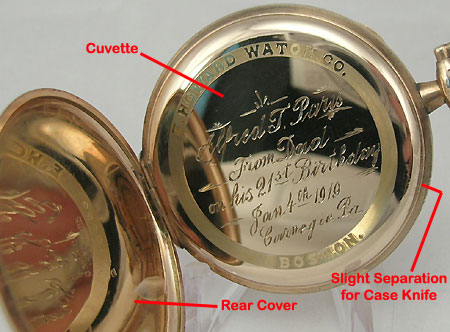
Sometimes you might encounter is the swing out case. With this case, the watch movement is mounted to a hinged ring that swings out of the case back. The swing out case is shown in the photo below. This type of case almost always has a front bezel that screws on and off. To open this case, first remove the front bezel by unscrewing it. Now you will be able to see the hinge at the top of the swing out ring. You will also see a thumbnail cut-out at the bottom. Before proceeding, however, it is important to make sure the crown is in the ‘set’ position. Even if this is a lever set watch, the crown will pull up a short distance. It is important to pull up the crown because the stem extends through the swing out ring. If you attempt to lift the ring out with the crown in the wind position, you can break the stem or other components of the winding mechanism. With the crown in the ‘set’ position, put your thumbnail in the thumbnail cutout and try to lift the ring. If it seems to catch after being lifted slightly, it may be hanging up on the stem. Turn the crown a bit while gently lifting to see if it releases. Do not force this. If it won’t open, it’s off to your friendly neighborhood qualified watch repair person.
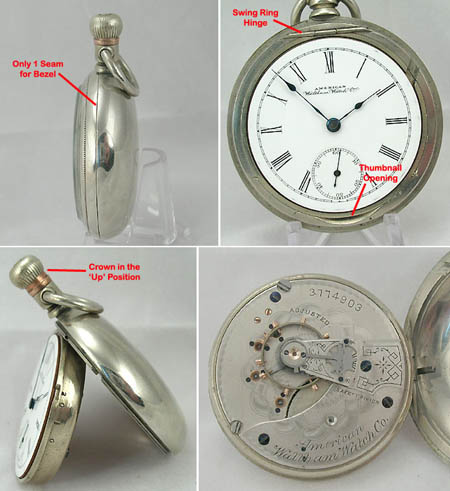
So, now that you know about the kinds of cases, lets look at what the cases could be made of. There were several metals commonly used, varying by cost. These were nickel, silver, gold filled, and solid gold. Let’s start with nickel. Nickel was the least expensive material at the time. It was given a number of different names by watch case makers to make it appear to be something that it wasn’t. You will see names like silveroid, ore silver, silverine, silverode, Alaska silver, and, occasionally even nickel.
Next, we have cases that were actually made of silver. The most common marking you will see is COIN SILVER or sometimes simply COIN. In North America, coin silver is usually 90% silver mixed with some other metal to add strength and wearability. You will also occasionally see STERLING, which is 92.5% silver. Less common in American cases (but common in European cases) is .800 SILVER, which is 80% silver.
Then we have gold filled cases. These are fairly common and often confuse people as to whether they are solid gold. Gold filled differs from gold plating in the process used. Gold filled metal is created by starting with a sandwich of metal in which the two slices of ‘bread’ are gold and the ‘meat’ is some less valuable metal – usually brass. This heated sandwich is repeatedly run through a roller press until the desired thickness of metal is achieved. You will rarely see the term ‘gold filled’ on a case. Instead, the usual sign that a case is gold filled is that there will be some indication that it is guaranteed to wear for a certain number of years. The number of years typically ranged between 5 and 25 years. The longer wearing cases would usually have a thicker layer of gold over the brass and, therefore, would indeed wear longer. (There is a certain bit of marketing going on here, just as there is today with some items like car batteries. You will sometimes see a case that is ‘guaranteed to wear permanently’. There is probably no difference between this case and a 20-year case but it sounds better and the manufacturer is betting that, after 20 years, you won’t even remember where you bought it!) Some of these gold filled marks are shown below. Note that the mark on the right doesn’t say anything about metal content. This is a mark used by the Keystone Watch Case Company – one of the largest case manufacturers. The scales by themselves indicate that the case is a 20-year case. If there is a crown over the scales, then the case is a 25-year case.
Gold filled cases can wear if used for a long period of time. When the wear extends through the outer gold layer, the underlying brass is exposed. This is referred to as brassing. It is very easy to see the brassing because of the patina the brass takes on when it has not been polished. If your case does have brasssing, it can still be made quite presentable with a good polish. (Use a high quality, non-abrasive polish like Simichrome.) This also points out that one must be careful when buying a watch in a gold filled case in an online auction. If the case is nicely polished, you may not be able to see any brassing in the photos. Lastly we have solid gold cases.Typically you will only see a 14K or 18K (in European cases, there will be quite a few hallmarks) stamp along with the manufacturer’s name. Sadly, a relatively small percentage of solid gold cases survive today – many having been melted down during the great depression and during other periods when the price of gold rose to high levels.
So, there you have it, the scoop on cases. Next time, I’ll discuss the different methods of setting a pocket watch, an overview of movements, and what to look for when looking at a movement.
